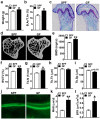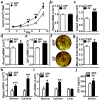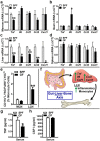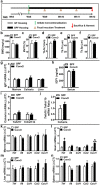Commensal Gut Microbiota Immunomodulatory Actions in Bone Marrow and Liver have Catabolic Effects on Skeletal Homeostasis in Health
- PMID: 28720797
- PMCID: PMC5515851
- DOI: 10.1038/s41598-017-06126-x
Commensal Gut Microbiota Immunomodulatory Actions in Bone Marrow and Liver have Catabolic Effects on Skeletal Homeostasis in Health
Abstract
Despite knowledge the gut microbiota regulates bone mass, mechanisms governing the normal gut microbiota's osteoimmunomodulatory effects on skeletal remodeling and homeostasis are unclear in the healthy adult skeleton. Young adult specific-pathogen-free and germ-free mice were used to delineate the commensal microbiota's immunoregulatory effects on osteoblastogenesis, osteoclastogenesis, marrow T-cell hematopoiesis, and extra-skeletal endocrine organ function. We report the commensal microbiota has anti-anabolic effects suppressing osteoblastogenesis and pro-catabolic effects enhancing osteoclastogenesis, which drive bone loss in health. Suppression of Sp7(Osterix) and Igf1 in bone, and serum IGF1, in specific-pathogen-free mice suggest the commensal microbiota's anti-osteoblastic actions are mediated via local disruption of IGF1-signaling. Differences in the RANKL/OPG Axis in vivo, and RANKL-induced maturation of osteoclast-precursors in vitro, indicate the commensal microbiota induces sustained changes in RANKL-mediated osteoclastogenesis. Candidate mechanisms mediating commensal microbiota's pro-osteoclastic actions include altered marrow effector CD4+T-cells and a novel Gut-Liver-Bone Axis. The previously unidentified Gut-Liver-Bone Axis intriguingly implies the normal gut microbiota's osteoimmunomodulatory actions are partly mediated via immunostimulatory effects in the liver. The molecular underpinnings defining commensal gut microbiota immunomodulatory actions on physiologic bone remodeling are highly relevant in advancing the understanding of normal osteoimmunological processes, having implications for the prevention of skeletal deterioration in health and disease.
Conflict of interest statement
The authors declare that they have no competing interests.
Figures








Similar articles
-
Antibiotic Perturbation of Gut Microbiota Dysregulates Osteoimmune Cross Talk in Postpubertal Skeletal Development.Am J Pathol. 2019 Feb;189(2):370-390. doi: 10.1016/j.ajpath.2018.10.017. Epub 2019 Jan 16. Am J Pathol. 2019. PMID: 30660331 Free PMC article.
-
Specific Commensal Bacterium Critically Regulates Gut Microbiota Osteoimmunomodulatory Actions During Normal Postpubertal Skeletal Growth and Maturation.JBMR Plus. 2020 Jan 30;4(3):e10338. doi: 10.1002/jbm4.10338. eCollection 2020 Mar. JBMR Plus. 2020. PMID: 32161843 Free PMC article.
-
Commensal oral microbiota induces osteoimmunomodulatory effects separate from systemic microbiome in mice.JCI Insight. 2022 Feb 22;7(4):e140738. doi: 10.1172/jci.insight.140738. JCI Insight. 2022. PMID: 35077397 Free PMC article.
-
Symbiotic and antibiotic interactions between gut commensal microbiota and host immune system.Medicina (Kaunas). 2015;51(2):69-75. doi: 10.1016/j.medici.2015.03.001. Epub 2015 Mar 24. Medicina (Kaunas). 2015. PMID: 25975874 Review.
-
The intestinal microbiome and skeletal fitness: Connecting bugs and bones.Clin Immunol. 2015 Aug;159(2):163-9. doi: 10.1016/j.clim.2015.03.019. Epub 2015 Apr 1. Clin Immunol. 2015. PMID: 25840106 Free PMC article. Review.
Cited by
-
Tetracyclines and bone: Unclear actions with potentially lasting effects.Bone. 2022 Jun;159:116377. doi: 10.1016/j.bone.2022.116377. Epub 2022 Mar 3. Bone. 2022. PMID: 35248788 Free PMC article. Review.
-
Temporal evolution of the microbiome, immune system and epigenome with disease progression in ALS mice.Dis Model Mech. 2019 Nov 15;13(2):dmm041947. doi: 10.1242/dmm.041947. Dis Model Mech. 2019. PMID: 31597644 Free PMC article.
-
Antibiotic Perturbation of Gut Microbiota Dysregulates Osteoimmune Cross Talk in Postpubertal Skeletal Development.Am J Pathol. 2019 Feb;189(2):370-390. doi: 10.1016/j.ajpath.2018.10.017. Epub 2019 Jan 16. Am J Pathol. 2019. PMID: 30660331 Free PMC article.
-
Commensal gut bacterium critically regulates alveolar bone homeostasis.Lab Invest. 2022 Apr;102(4):363-375. doi: 10.1038/s41374-021-00697-0. Epub 2021 Dec 21. Lab Invest. 2022. PMID: 34934182 Free PMC article.
-
Specific Commensal Bacterium Critically Regulates Gut Microbiota Osteoimmunomodulatory Actions During Normal Postpubertal Skeletal Growth and Maturation.JBMR Plus. 2020 Jan 30;4(3):e10338. doi: 10.1002/jbm4.10338. eCollection 2020 Mar. JBMR Plus. 2020. PMID: 32161843 Free PMC article.
References
Publication types
MeSH terms
Substances
Grants and funding
LinkOut - more resources
Full Text Sources
Other Literature Sources
Molecular Biology Databases
Research Materials
Miscellaneous

